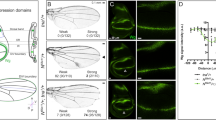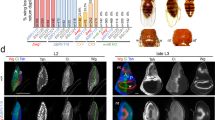Abstract
In Drosophila, as in mammals, epidermal differentiation is controlled by signalling cascades1 that include Wnt proteins2,3 and the ovo/shavenbaby (svb) family of zinc-finger transcription factors4,5,6. Ovo/svb is a complex gene with two genetic functions corresponding to separate control regions: ovo is required for female germline development and svb for epidermal morphogenesis7,8. In the Drosophila embryo, the ventral epidermis consists of the segmental alternance of two major cell types that produce either naked cuticle or cytoplasmic extrusions known as denticles. Wingless signalling specifies smooth cells that produce naked cuticle9, whereas the activation of the Drosophila epidermal growth factor (EGF) receptor (DER) leads to the production of denticles10. Here we show that expression of the ovo/svb gene controls the choice between these cell fates. We find that svb is a key selector gene that, cell autonomously, directs cytoskeletal modifications producing the denticle. The DER pathway promotes denticle formation by activating svb expression. Conversely, Wingless promotes the smooth cell fate through the transcriptional repression of svb bythe bipartite nuclear factor Armadillo/dTcf. Our data indicatethat transcriptional regulation of svb integrates inputs fromthe Wingless and DER pathways and controls epidermal differentiation.
This is a preview of subscription content, access via your institution
Access options
Subscribe to this journal
Receive 51 print issues and online access
$199.00 per year
only $3.90 per issue
Buy this article
- Purchase on Springer Link
- Instant access to full article PDF
Prices may be subject to local taxes which are calculated during checkout




Similar content being viewed by others
References
Oro, A. E. & Scott, M. P. Splitting hairs: dissecting roles of signaling systems in epidermal development. Cell 95, 575–578 (1998).
Gat, U., DasGupta, R., Degenstein, L. & Fuchs, E. De Novo hair follicle morphogenesis and hair tumors in mice expressing a truncated beta-catenine in skin. Cell 95, 605–614 (1998).
Perrimon, N. The genetic basis of patterned baldness in Drosophila. Cell 76, 781–784 (1994).
Dai, X. et al. The ovo gene required for cuticle formation and oogenesis in flies is involved in hair formation and spermatogenesis in mice. Genes Dev. 12, 3452–3463 (1998).
Mevel-Ninio, M., Terracol, R. & Kafatos, F. C. The ovo gene of Drosophila encodes a zinc finger protein required for female germ line development. EMBO J. 10, 2259–2266 (1991).
Lu, J., Andrews, J., Pauli, D. & Oliver, B. Drosophila OVO zinc-finger protein regulates ovo and ovarian tumor target promoters. Dev. Genes Evol. 208, 213–222 (1998).
Garfinkel, M. D., Wang, J., Liang, Y. & Mahowald, A. P. Multiple products from the shavenbaby-ovo gene region of Drosophila melanogaster : relationship to genetic complexity. Mol. Cell. Biol. 14, 6809–6818 (1994).
Mevel-Ninio, M., Terracol, R., Salles, C., Vincent, A. & Payre, F. ovo, a Drosophila gene required for ovarian development, is specifically expressed in the germline and shares most of its coding sequences with shavenbaby, a gene involved in embryo patterning. Mech. Dev. 49, 83–95 (1995).
Noordermeer, J., Johnston, P., Rijsewijk, F., Nusse, R. & Lawrence, P. A. The consequences of ubiquitous expression of the wingless gene in the Drosophila embryo. Development 116, 711–719 (1992).
Szuts, D., Freeman, M. & Bienz, M. Antagonism between EGFR and Wingless signalling in the larval cuticle of Drosophila. Development 124, 3209–3219 (1997).
Lawrence, P. A., Sanson, B. & Vincent, J. P. Compartments, wingless and engrailed : patterning the ventral epidermis of Drosophila embryos. Development 122, 4095–4103 (1996).
O'Keefe, L. et al. Spitz and Wingless, emanating from distinct borders, cooperate to establish cell fate across the Engrailed domain in the Drosophila epidermis. Development 124, 4837–4845 (1997).
Dougan, S. & DiNardo, S. Drosophila wingless generates cell type diversity among engrailed expressing cells. Nature 360, 347–350 (1992).
Brand, A. H. & Perrimon, N. Targeted gene expression as a means of altering cell fates and generating dominant phenotypes. Development 118, 401–415 (1993).
Mevel-Ninio, M., Fouilloux, E., Guenal, I. & Vincent, A. The three dominant female-sterile mutations of the Drosophila ovo gene are point mutations that create new translation-initiator AUG codons. Development 122, 4131–4138 (1996).
Dickinson, W. J. & Thatcher, J. W. Morphogenesis of denticles and hairs in Drosophila embryos: involvement of actin-associated proteins that also affect adult structures. Cell Motil. Cytoskeleton 38, 9–21 (1997).
Peifer, M., Sweeton, D., Casey, M. & Wieschaus, E. wingless signal and Zeste-white 3 kinase trigger opposing changes in the intracellular distribution of Armadillo. Development 120, 369–380 (1994).
Cadigan, K. M. & Nusse, R. Wnt signaling: a common theme in animal development. Genes Dev. 11, 3286–3305 (1997).
Barth, A. I., Nathke, I. S. & Nelson, W. J. Cadherins, catenins and APC protein: interplay between cytoskeletal complexes and signaling pathways. Curr. Opin. Cell Biol. 9, 683–690 (1997).
Pai, L. M., Orsulic, S., Bejsovec, A. & Peifer, M. Negative regulation of Armadillo, a Wingless effector in Drosophila. Development 124, 2255–2266 (1997).
Brunner, E., Peter, O., Schweizer, L. & Basler, K. pangolin encodes a Lef-1 homologue that acts downstream of armadillo to transduce the Wingless signal in Drosophila. Nature 385, 829–833 (1997).
Riese, J. et al. LEF-1, a nuclear factor coordinating signaling inputs from wingless and decapentaplegic. Cell 88, 777–787 (1997).
van de Wetering, M. et al. Armadillo coactivates transcription driven by the product of the Drosophila segment polarity gene dTCF. Cell 88, 789–799 (1997).
Yu, X., Riese, J., Eresh, S. & Bienz, M. Transcriptional repression due to high levels of Wingless signalling. EMBO J. 17, 7021–7032 (1998).
Sanson, B., White, P. & Vincent, J. P. Uncoupling cadherin-based adhesion from wingless signalling in Drosophila. Nature 383, 627–630 (1996).
Schweitzer, R., Shaharabany, M., Seger, R. & Shilo, B. Z. Secreted Spitz triggers the DER signaling pathway and is a limiting component in embryonic ventral ectoderm determination. Genes Dev. 9, 1518–1529 (1995).
Lee, T., Feig, L. & Montell, D. J. Two distinct roles for Ras is a developmentally regulated cell migration. Development 122, 409–418 (1996).
Schweitzer, R. & Shilo, B. Z. Athousand and one roles for the Drosophila EGF receptor. Trends Genet. 13, 191–196 (1997).
Cadigan, K. M., Fish, M. P., Rulifson, E. J. & Nusse, R. Wingless repression of Drosophila frizzled 2 expression shapes the Wingless morphogen gradient in the wing. Cell 93, 767–777 (1998).
Gabay, L., Seger, R. & Shilo, B. Z. In situ activation pattern of Drosophila EGF receptor pathway during development. Science 277, 1103–1106 (1997).
Acknowledgements
We thank M. Freeman, D. Montell, C. Nusslein-Volhard, M. Peifer, B. Shilo, J. P. Vincent, E. Wieschaus, and the Bloomington Stock centre for fly stocks; S. Cohen for providing the Wingless monoclonal antibody; C. Ardourel and M. J. Guinaudy for technical assistance; M. Mével-Ninio, B. Oliver, J. P. Vincent and the members of the lab for stimulating discussions; and B. Oliver, J. P. Vincent and J. Smith for comments on the manuscript. This work was supported by grants from the Centre National de la Recherche Scientifique.
Author information
Authors and Affiliations
Corresponding author
Rights and permissions
About this article
Cite this article
Payre, F., Vincent, A. & Carreno, S. ovo/svb integrates Wingless and DER pathways to control epidermis differentiation. Nature 400, 271–275 (1999). https://doi.org/10.1038/22330
Received:
Accepted:
Issue Date:
DOI: https://doi.org/10.1038/22330
This article is cited by
-
OVOL2 impairs RHO GTPase signaling to restrain mitosis and aggressiveness of Anaplastic Thyroid Cancer
Journal of Experimental & Clinical Cancer Research (2022)
-
Functional characterization of BmOVOs in silkworm, Bombyx mori
BMC Genomics (2019)
-
OVOL2 induces mesenchymal-to-epithelial transition in fibroblasts and enhances cell-state reprogramming towards epithelial lineages
Scientific Reports (2019)
-
Shavenbaby and Yorkie mediate Hippo signaling to protect adult stem cells from apoptosis
Nature Communications (2018)
-
Coupling optogenetics and light-sheet microscopy, a method to study Wnt signaling during embryogenesis
Scientific Reports (2017)
Comments
By submitting a comment you agree to abide by our Terms and Community Guidelines. If you find something abusive or that does not comply with our terms or guidelines please flag it as inappropriate.



